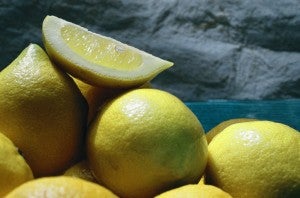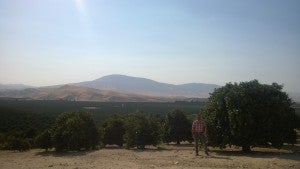 A common misperception is that citrus season is in the summer, but peak citrus season is actually happening right now.
A common misperception is that citrus season is in the summer, but peak citrus season is actually happening right now.
California grew over 90 percent of U.S. lemons last season, but the severe drought in 2015 caused a 9 percent dip in domestic lemon production compared to the previous growing season. This meant higher costs for farmers, consumers – and the planet.
In honor of peak citrus season, I asked Bakersfield citrus grower John S. Gless how he’s getting more crop per drop of fertilizer and water through “fertigation,” why efficiency and sustainability practices are good investments, and why land stewardship is a core part of farming.
Can you give me a quick rundown of your operation?
Our current family operation at Gless Ranch spans 7,000 acres in Kern and Riverside counties. The vast majority of our crop is citrus fruits — oranges, tangerines, lemons, you name it. We also grow avocados in Riverside, and expanded into the Coachella Valley where we farm figs and dates.
Over the years, we’ve been able to expand from our first location in Riverside because of the innovation and foresight of my family. By working with the University of California at Riverside to develop groundbreaking pest management solutions for citrus growers, we’ve been a part of the dramatic decrease in pesticide use in California citrus. Integrated pest management has saved us time and money.
How you are maximizing water usage?
I’ve been using drip irrigation and micro irrigation systems on my farm since the 1980s, but I’m always on the lookout for other ways we can increase efficiency even further. For example, we’ve built on-farm reservoirs to collect and store leftover water from our filtration system. That recaptured water is then re-filtered, pumped back into the irrigation system and used again.
Using water as efficiently as possible isn’t just good for the planet, it also makes plain business sense.
It’s important to note that there’s no one size fits all when it comes to irrigation, and you have to use whatever methods are best for your land. Even within my acreage, there are many different soil types, so irrigation strategies aren’t the same in all parts of my groves.
What are some of the sustainability measures you’re implementing on your farm?
My trees need fertilizer and irrigation, but I don’t want to be applying more water or fertilizer than is needed because that would be a waste of money. One way we’re doing this is by working with our agronomist and pest control advisor to conduct a comprehensive leaf and soil analysis before we develop our nutrient prescriptions.
Fertigation, or applying fertilizers, water, and soil amendments through irrigation systems, is also a great way to use these resources as efficiently as possible. With improved fertigation technology, I can constantly monitor water pressure to make sure I’m not wasting a drop of inputs. Fertigation holds tremendous potential for farmers to understand the resources they manage even better.
We’ve also taken advantage of a service provided by the USDA’s Natural Resources Conservation Service (NRCS). Experts from NRCS will come out to my farm to check irrigation practices and make recommendations – at no cost.
What are the barriers to widespread adoption of micro irrigation?
Micro irrigation requires constant maintenance, and growers need to stay on top of upkeep. That can be time intensive and costly. But in the long-run it absolutely saves time and money, especially given the price of water today.
This past year, water represented 40 percent of my input costs. But I need to do whatever it takes to give the trees what they need to survive. The good news is that conservation measures have economic benefits – so I think that will lead to widespread adoption.
Why are you putting so much effort into efficiency?
I’ve been working on our farm since I was 14-years old, but the technological advancements over the past few years are like nothing I’ve ever seen. The opportunities for efficiency and cost-savings are unprecedented. So is the urgency. We have an increasing responsibility to preserve land quality to maintain productivity. I want to make sure Gless Ranch is around for at least another four generations!
The more I know about how much fertilizer and water I’m applying to my fields, the better sense I have of my needs. Because of this, when I’m planning out water use and allocation, I can project exactly how much water an orchard is going to use, within a few acre feet.
Knowing your exact usage of water and fertilizer is extremely useful. It saves me resources in the end and makes our operation more successful.











